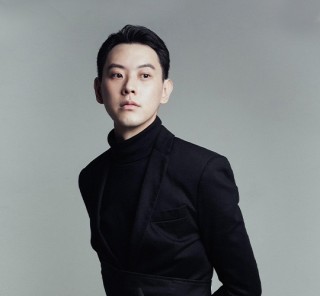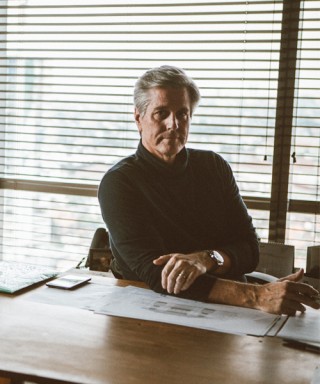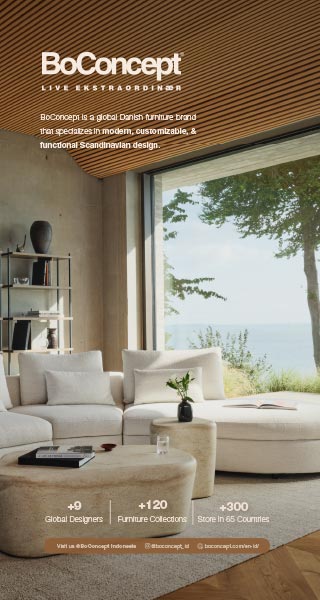
Lorenzo Rudolf In Conversation With Disaphol Chansiri
Published by Sugar & Cream, Thursday 05 January 2017
Text and Images courtesy of Art Stage Singapore
Lorenzo Rudolf In Conversation With Disaphol Chansiri
Disaphol Chansiri currently teaches law at Assumption University in Bangkok. He is one of Thailand’s leading collectors.

Chatchai Puipai, My Heart is a Lonely Painter, 2006, Oil on canvas, 311.6 cm x 190 cm.
LR: Disaphol, when did you start collecting? And what did you start with?
DC: I started buying when I was in college (Chulalongkorn University), and back then in Thailand I mostly bought Thai art. That was over twenty years ago.
LR: What motivated you to buy art at the time? I’ve been in the art world for more than 25 years now, but back when I was in college, I wanted to be an artist much more than I wanted to buy art.
DC: Because I know myself – I cannot draw and paint! Of course, it’s probably similar to many people who like art today – to own something worthwhile, like a right of passage. My family doesn’t have a tradition of collecting, except for my grandmother who loves to buy Chinese art.
LR: How many pieces do you have in your collection today?
DC: I have not been that good at keeping track. So my current project is to do an inventory and catalogue everything.
LR: Why do you keep collecting? It’s not about the walls anymore, I’m sure.
DC: I think it’s always interesting to go somewhere and see something new. You know, I’m a lawyer by training, and I’ve always been interested in global affairs. In paintings, artists are always exploring current issues – culture, politics – so it’s always fun, I enjoy seeing how they explore these themes. And I’ve said before that my collection is like my diary, I can tell you what was happening at the time I acquired each piece of work.
LR: In other words, actualising your diary through art is like the fil rouge of your collection. Can you share what the recent pages in your “diary” look like?
DC: Right now, I’ve moved back to Thailand, so my interest is in my region, in Asia. I’m constantly researching and learning about social issues and the political situation in Southeast Asia, and how it drives art.
LR: There’s a particular artist that you’re close to, much so that he has even brought me to your place to see his work there. What is your relationship with Navin Rawanchaikul as an artist, and why does his work interest you?
DC: The first time I encountered his work was in an art book, and it really struck me even though I didn’t know who Navin was at the time. I loved that work, but I was still quite young then, and not yet serious about collecting. I saw his work again at the Museum of Contemporary Art in Tokyo, and I thought it was really fun and that’s how I started getting more into his work. We were introduced by our mutual friend Gridthiya Gaweewong at a museum opening in Berlin, and that’s how I got to know him personally.
LR: What fascinates you about his work?
DC: I think it’s because he always surprises me, especially with his new series. I’m always looking forward to what he comes up with next. His work is really fun – there’s a lot of humour but it’s sentimental at the same time. There are so many beautiful works. He created a series for a show I was having to exhibit my private collection, it was centred around his community up in Chiangmai and it was amazing. It was like having a historical record of a certain community. He’s actually having a show up in Songkhla right now, I haven’t been yet but I’m planning to go before it ends. I even told all my friends living there to go and support the show!
LR: It’s interesting that you mention Navin and the community – social engagement is a common thread amongst many big artists here. Has that always been a part of your development as a collector?
DC: Yes that’s what I like about Navin, he creates something for the community, for people to learn. At the end of the day, you cannot just put things in the museum or gallery, I like the idea of educating people, of bringing art to the community, even if it’s the shopping mall. Because in a way, it’s kind of like nurturing our new culture.
LR: Navin’s studio is located in Chiangmai, and many other artists also live and work in Chiangmai: Rikrit Tiravanija, Kamin Lertchaiprasert, Mit Jai Inn, the film-maker Apichatpong Weerasethakul, the multimedia artist Araya Rasdjarmrearusook, etc. They made Changmai a unique, community-related art location;it’s not something you see in other countries. Can you explain this development in Chiangmai?
DC: In Navin’s case, he’s from Chiangmai. The city itself is a beautiful place to live, and it has one of the best art schools. Whenever you go up to Chiangmai, there’s a really special feeling. That’s why I’m happy to see more and more people moving up to Chiangmai to live, work, and show their collection.
LR: Indeed, collector Jean-Michel Beurdeley opened his private museum in Changmai, the wonderful MAIIAM Museum of Contemporary Art. Another collector, Petch Osathanugrah, will do the same soon in Bangkok. Do you have future plans to share your collection publicly?
DC: I have a space in Chiangmai and Bangkok, both are open to the public by appointment. They are very small spaces because they are in my residence, but everyone is welcome, you just have to let us know in advance so someone can be there to open the door.
LR: Now that we’ve spoken about Navin, which other artists do you consider favourites, or have close relationships with?
DC: I love Chatchai Puipia. For the new generation, I love Korakrit Arunanondchai. He first brought me to see his work at the MoMA PS1 and it was incredible. After that, I always try to go to his shows whenever I can, like the ones in Beijing and Paris. He actually just had one in Berlin, but unfortunately I couldn’t make that. I love Modern art from the older generation as well. Maybe it comes with age, because I started with Thai Modern, and my taste has changed so much along the way, but now that I’ve come back to Thailand, I’ve started looking into other Modern work as well.
LR: Do you only collect Thai art?
DC: No, I collect very internationally. My collection is, as I mentioned before, like my diary so it really depends on where I’m living and what my interest are at the time. When I was living in the U.S., I collected mostly American art for ten years. After moving back to Asia, I concentrate more on Asian art.
LR: Many aspects of the Thai art scene are gaining momentum. I recall that a few years back, many galleries were more of alternative art spaces, there wasn’t a very strong gallery scene, and now you see many new galleries opening – young, avant-garde, very edgy. Some examples include TARS, VER, NOVA Gallery, they are all very professional. TANG Gallery just opened a new big space with an impressive show. What’s happening, is the market changing?
DC: To me, I think now that Thai people have developed an interest in art, they are looking for freshness and variety. Similarly, all the younger gallerists are having fun with their projects, and that’s always nice to see. They are giving the public options in terms of how they choose to spend their time, it doesn’t always have to be about shopping malls anymore, and I’m really happy to witness all these things picking up.
LR: I see quite a mixed crowd at these gallery openings. There’s a new generation here that’s very serious about art, and they are beginning to buy.
DC: With the media and everything around it, art has started to gain traction and presence, and people are starting to realise that they are surrounded by art. There are also more new art schools, and more conversations created about art. I don’t want to use the word “trendy”, but there’s definitely a certain level of interest out there because art has become quite socially compelling these days. It’s not just a hobby – it’s culture, tradition, part of education, and as a teacher myself, I’m very pleased with this development.
LR: I’ve also observed that the interest of this new generation is not strictly limited to Thailand, they have a much broader scope; they buy international too. Is this because they travel more?
DC: Actually, now you don’t really have to travel – there’s the internet, magazines, catalogues. A lot of them have lived abroad or studied abroad, and that’s where the exposure usually starts, but then buying art has become quite accessible these days.
LR: International art is oftentimes expensive when compared to Thai art.
DC: Yes, Thai art is comparatively more affordable so I would encourage people to buy Thai art.
LR: If I would like to start getting into Thai art, and discover some young emerging Thai artists, who should I look out for?
DC: I probably can’t mention any names, but what you can do is go to graduate shows and see what the art students are producing. Like I just bought this incredible work from a young student from the South, it’s so good. I always try to support students as much as I can, because they need our support – hopefully it encourages to go further and not give up on their art.
LR: If I’m interested to know more about Thai contemporary art, what would you say makes it special and distinctive?
DC: We have some of the best conceptual art in Asia, such as Rirkrit Tiravanija, Araya Rasdjarmrearusook, they are who I am proud of, and you can tell because their work is very interesting.
LR: I agree with you. Frankly speaking, Southeast Asia was all about Rirkrit for a period of time in the art world. So in a way, the international perception of contemporary started with Thailand, and right now, you have a diverse art scene with even more to discover. Lots of international people are coming to Thailand for its art, and Thai art is going out, and that’s also because people like you are supporting international recognition for Thai art.
DC: Lots of international artists want to move and work here too, because the cost of living in Thailand is very reasonable. The weather is nice, people are sweet. I’ve heard about lots of artists from the West who want to live and work here, and I say, come enjoy the sun!
LR: Thank you, Disaphol.
 118
25/12/2025
118
25/12/2025
MERACIK HARAPAN DI TENGAH BENCANA: SOLIDARITAS STARBUCKS UNTUK SUMATERA
Di tengah bencana yang melanda Sumatera, kepedulian hadir melalui akses air bersih, bantuan darurat, dan dukungan pemulihan bagi komunitas...
read more 3.24K
25/12/2025
3.24K
25/12/2025
FESTIVE HOLIDAY GIFT GUIDE — L’OCCITANE EN PROVENCE
This festive season, L’OCCITANE en Provence presents The Light Catcher and its three limited-edition collections, bringing the radiant glow of Provence...
read more 11.00K
03/12/2025
11.00K
03/12/2025
LIVING DIVANI ILLUMINATES THE FESTIVE SEASON IN SHADES OF DEEP RED AND LUMINOUS SILVER
Living Divani illuminates the festive season in shades of deep red and luminous silver, reimagining its iconic designs with festive radiance.”
read more 10.68K
26/11/2025
10.68K
26/11/2025
MOROSO AT ARTVERONA 2025: DESIGN AS DIALOGUE
Design as language – Moroso’s presence at the heart of ArtVerona’s 20th Edition
read more 81.64K
10/01/2025
81.64K
10/01/2025
W RESIDENCE IN SOUTH JAKARTA BY MICHAEL CHANDRA
Michael Chandra, founder of MNCO Studio Design has created the W Residence with an aesthetically pleasing, practical, and pleasant home from all...
read more 44.45K
11/07/2025
44.45K
11/07/2025
PELUNCURAN PERDANA LEGANO HOME MENGGANDENG AGAM RIADI DI ST REGIS RESIDENCE JAKARTA
Peluncuran perdana LEGANO HOME menggandeng Agam Riadi di St. Regis Residence Jakarta: menyatukan kemewahan dan jiwa dalam sebuah ruang.
read more















